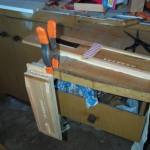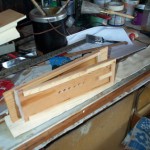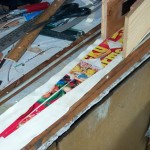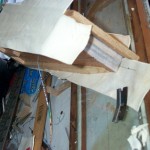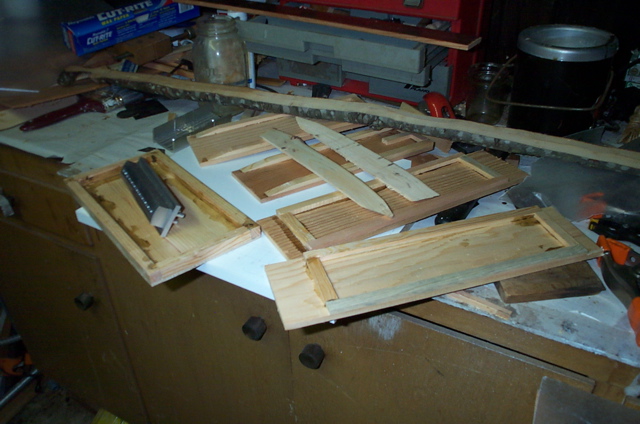Not sure if there is a point in counting the days anymore. Even without pipes the organ made it’s public debut on the weekend. Saturday It was shown at the MBSI Ardenwood meeting. Where there was a nice table on the side porch to display the work in progress.
I forgot the camera, however several others did manage to take some photographs. These may be sent to the MMD for publication.
Several friends stopped by Ardenwood, Including Russ Doering, who gave me some pipe wood. I think the scrap from these pipes were used to make the pump and regulators.
Sunday was an eventful day. I wanted to be in three places at the same time. Two of the events were close together, So the organ first went to the AMICA meeting, Hosted by Bob Gonzales in Marin. I then stopped by for the last hour at the Shoenstein open House in Benicia.
My experiment to locate a time machine sometime in the future, seems to have failed, So I was not able to attend the second day at Ardenwood. Even so I was fortunate to attend two event happening at the same time.
It was not my intention to take the organ into the Shoenstien factory, as they were showing off a rather nice large organ, and a much smaller one. Mentioning I had the organ in the car with me, I was invited by the owner Jack Bethards to bring the organ inside and show it. Jack is good friends with Russ. Probably the wood pipes I made the wind pumps and reservoir passed through Shoenstien at some time.
This makes the little one week wonder as I have been calling it a success in that many of the people who indirectly helped collaborate on it, got to see the results first hand.
While showing the instrument to a visitor at Ardenwood, I noted that the wood used was made from found scraps of wood. I was real pleased when they remarked that the organ was “green.” as this was the point of the project.
After the Shoenstien Open house, a few friends of Harold, who made the crankshaft and roll mechanism, also in the same week, had a nice dinner to wind down from a Hectic weekend.
It was also nice to see some of the same people, both days at different events. This means I was not the only one multiplexing everything at once.
Aldo Laus at Mell Wright’s excellent busker site estimated that it should take 54 working hours to make the 650 or so parts at 5 minutes per part. This is way over optimistic. I spent about 16 hours a day for 8 days which works out to 128 hours. A lot more than the typical normal 40 hours allotted for work. Aldo estimates, that there are about 290 or so parts not counting the pipes. Many of these parts took more than an hour to layout measure, check and measure again, before cutting.
I think I was wise to start with the bellows, as having built and recovered a number of singing bird bellows, I find the valves on these items to be tricky. The valves do need time to settle in.
I did not make the roll mechanism as this was done by Harold the project instigator. I suspect Harold spent more than 5 minutes on the parts he made.
This week will be spent making and voicing the pipes. I am not aware of any public events in the near future, Probably just as well as I will not have such an artificial deadline to deal with. I will admit that I had fun with this project. One of my former co-workers at Shoenstein, asked me if it was a Joke. I think they were correct in a way. That there was humor intended in setting out to do the nearly impossible task of making a quality product in a week.
Not that the final product was a joke, but the desire to do it in a week, was a bit tongue in cheek at first. Then developed into something serious.


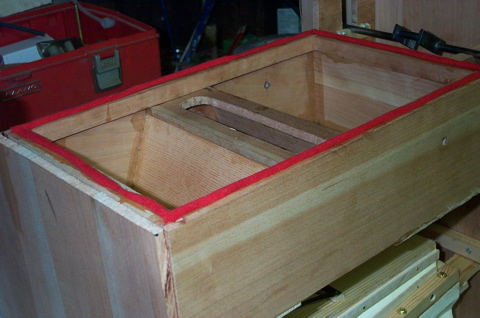 This is an interesting way of making a gasket. I am not sure if this is the best place for this method, but it seems worth a try. This is how Wurlitzer gaskets the regulators to the wind trunks.
This is an interesting way of making a gasket. I am not sure if this is the best place for this method, but it seems worth a try. This is how Wurlitzer gaskets the regulators to the wind trunks. 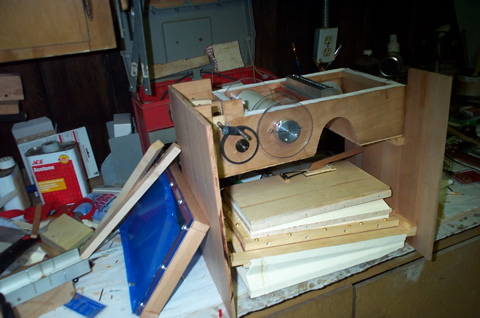 Finally we show the progress. All the main parts are in place and mounted to the sides. I did get a sheet of MDF for the pipe rack. Not sure when I will have time to cut it. I may just mount the pipes onto thin strips of board (I have a lot of that material.)
Finally we show the progress. All the main parts are in place and mounted to the sides. I did get a sheet of MDF for the pipe rack. Not sure when I will have time to cut it. I may just mount the pipes onto thin strips of board (I have a lot of that material.)

